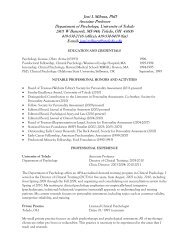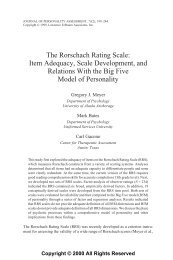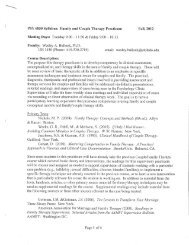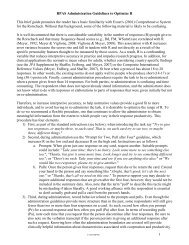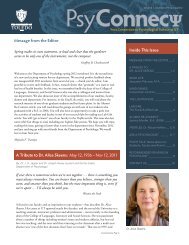916 Heffne• and Whitfield: <strong>Perception</strong> <strong>of</strong> <strong>the</strong> missing fundamental <strong>by</strong> cats 916TABLE I.Stimuli used in <strong>the</strong> missing fundamental test.Oscillators<strong>Missing</strong>A B Frequency fundamental(a) 342 ... 342 None400 ... 400 None458 ..- 458 None•) 342 1942 1600, 1942, 2284 342400 2000 1600, 2000, 2400 400458 2058 1600,2058, 2516 458(c) 342 2058 1716, 2058, 2400 342400 2000 1600,2000, 2400 400458 1942 1484, 1942, 2400 458DirectionFrequencyStandardUpDownStandardUpU pStandardDown<strong>of</strong> Change<strong>Missing</strong>fundamentalß ß ß'-'DownStandardUpDownStandardU pindependent ascillators and a balanced modulator. Toproduce <strong>the</strong> three-tone stimulus (triad), <strong>the</strong> output a/oscillator A was added to and subtracted from <strong>the</strong> centerfrequency produced <strong>by</strong> oscillator B and ali threefrequencies were combined. Th e frequency <strong>of</strong> oscillatorA thus determined <strong>the</strong> spacing <strong>of</strong> <strong>the</strong> three frequencies<strong>of</strong> <strong>the</strong> triad, and hence <strong>the</strong> frequency <strong>of</strong> <strong>the</strong>fundamental. By stepping <strong>the</strong> two oscillators throughequal increments <strong>of</strong> frequency, ei<strong>the</strong>r up or down andin <strong>the</strong> same or opposite directions, <strong>the</strong> four types <strong>of</strong> triedpairs set out below and inTable I couldbe produced.The transducers were a 7.5-cm paper-cone speaker(used only in <strong>the</strong> initial stage <strong>of</strong> training) and an ionicloudspeaker (Ionophane 601, Fane Acoustics, Ltd. )which were placed 0.5 m in front<strong>of</strong><strong>the</strong> animal and directedtowards its head. The advantages <strong>of</strong> <strong>the</strong> latterspeaker are that it has a linear response in <strong>the</strong> range<strong>of</strong> <strong>the</strong> frequencies used in this experiment and that<strong>the</strong>re is no moving diaphragm to generate distortionproducts. In addition, it is matched to <strong>the</strong> air <strong>by</strong> asmall horn such that <strong>the</strong> system has a high-pass characteristic,giving considerable attenuation for frequenciesin <strong>the</strong> region below 1 kHz.Sound measurements were made <strong>by</strong> placing a microphone(Briiel& Kj•er «-in. model 4133) above <strong>the</strong> watercup in <strong>the</strong> position previously occupied <strong>by</strong> <strong>the</strong> cat's headand with its axis pointing directly at <strong>the</strong> loudspeaker.The sound level was measured with a Briiel & Kj•ermicrophone amplifier (model 2604) and •-octave filter(model 1614). Readings for <strong>the</strong> 1600, 2000, 2400 Hztriad were 63, 70, and 65 dB with <strong>the</strong> filters centeredon 1600, 2000, and 2500 Hz, respectively.Because <strong>of</strong> <strong>the</strong>ir small separation, <strong>the</strong> three components<strong>of</strong> a triad are not completely resolved <strong>by</strong> <strong>the</strong>filter system, so that adjacent components contributeto each reading.. The readings obtained would correspondto values for <strong>the</strong> respective components <strong>of</strong> about62, 68, and 64 dB SPL. In general and on this basis,<strong>the</strong> intensities <strong>of</strong> <strong>the</strong> components <strong>of</strong> <strong>the</strong> various triadsall fell within <strong>the</strong> range 65+3 dB SPL. No output couldbe detected within <strong>the</strong> band 12.5-1000 Hz.C. StimuliThe stimulus pairs were composed <strong>of</strong> ei<strong>the</strong>r singletones or triads in which <strong>the</strong> "standard" stimulus wasfollowed <strong>by</strong> a "comparison" stimulus <strong>of</strong> ei<strong>the</strong>r higheror lower frequency (Fig. 1)o The tone pairs were presentedat a rate <strong>of</strong> one pair/sec for 10 sec (290-msecduration, 20-msec rise-decay, with 10 msec betweenmembers <strong>of</strong> a pair and 410 msec between pairs). Thestimuli used may be divided into three categories (cf.Table I).(a) A standard tone <strong>of</strong> 400 Hz followed <strong>by</strong> a comparisontone c• ei<strong>the</strong>r 342 or 458 Hz [Table I(a)].(b) A standard triad <strong>of</strong> 1600, 2000, 2400 Hz followed<strong>by</strong> a comparison triad <strong>of</strong> ei<strong>the</strong>r 1600, 1942, and 2284Hz or 1600, 2058, and 2516 Hz [Table I(b)]. In humam<strong>the</strong>se triads produce <strong>the</strong> perception <strong>of</strong> a fundamentaltone (<strong>the</strong> missing fundamental) c• 400, 342, and458 Hz, respectivelyø It is important to no•e that when<strong>the</strong> standard triad is paired with ei<strong>the</strong>r <strong>of</strong> <strong>the</strong> two comparisontriads, <strong>the</strong> frequencies <strong>of</strong> both <strong>the</strong> triad and<strong>the</strong> missing fundamental change in <strong>the</strong> same directionrelative to <strong>the</strong> standard.(c) A standard triad <strong>of</strong> 1600, 2000, and 2400 Hzfollowed <strong>by</strong> a comparison triad <strong>of</strong> ei<strong>the</strong>r 1716, 2058,and 2400 Hz or 1484, 1942, and 2400 Hz [Table I(c)].fTANDARO ]z•JuJu.STANDARD''SAFEI 9 10WARNINGI 9 I0TIME ( sec )FIG. 1. Schematic representation <strong>of</strong> <strong>the</strong> tone pairs used in <strong>the</strong>missing fundamental test. The safe signal consisted <strong>of</strong> 10 tonepairs in which <strong>the</strong> second tone <strong>of</strong> each pair was <strong>of</strong> lower frequencythan <strong>the</strong> first or standard tone, The warning signalconsisted <strong>of</strong> 10 tone pairs in which <strong>the</strong> second tone was <strong>of</strong> higherfrequency than <strong>the</strong> standard. The animals were trained tomake an avoidance response upon presentation <strong>of</strong> <strong>the</strong> warningsignal and to ignore <strong>the</strong> safe signal.'J. Acou•t. So•. Am., VoL Eg, No. 4, April 1976
917 Heffner and Whitfield: <strong>Perception</strong> <strong>of</strong> <strong>the</strong> missing fundamental <strong>by</strong> c;ts 917•n this case, <strong>the</strong> frequencies <strong>of</strong> <strong>the</strong> triads and<strong>the</strong>missingfundamental produced <strong>by</strong> <strong>the</strong> triads change in <strong>the</strong>opposite direction relative to <strong>the</strong> standard. Thus, forexample, a person who perceived <strong>the</strong> missing fundamentalwould say that <strong>the</strong> comparison tone <strong>of</strong> <strong>the</strong> pairwas <strong>of</strong> higher frequency than <strong>the</strong> standard when in facttwo <strong>of</strong> <strong>the</strong> tones in <strong>the</strong> triad were lower. This stimulnscondition was <strong>the</strong>refore crucial in determining whe<strong>the</strong>ra subject perceived <strong>the</strong> missing fundamental.During initial training, it was discovered that <strong>the</strong>cats tended to respond to changes in <strong>the</strong> absolute frequency<strong>of</strong> <strong>the</strong> tones as well as to <strong>the</strong> direction <strong>of</strong> <strong>the</strong>shift in pitch. To reduce <strong>the</strong> possibility <strong>of</strong> an animalresponding to changes in absolute frequency, <strong>the</strong> settings<strong>of</strong> <strong>the</strong> two oscillators were randomly varied <strong>by</strong>as much as 10% for <strong>the</strong> stimuli listed in categories (a)and (b) [but not (c)]. This procedure also served to reduce<strong>the</strong> possibility that <strong>the</strong> task could be solved on <strong>the</strong>basis <strong>of</strong> changes in intensity which might have beenassociated with changes in frequency.O. Procedure.Briefly, <strong>the</strong> cats were trained to maintain contactwith <strong>the</strong> water cup for a water reward. After a reasonablysteady rate <strong>of</strong> contact was attained, trials werebegun which consisted <strong>of</strong> <strong>the</strong> presentation <strong>of</strong> one <strong>of</strong> twotone patterns for 10 sec. - If <strong>the</strong> tone pattern had arising pitch sequence, <strong>the</strong> cat had to cease licking within3 sec <strong>of</strong> tone onset in order to avoid an electricshock which would o<strong>the</strong>rwise be delivered to <strong>the</strong> ani-mal's feet at tone <strong>of</strong>fset. This conditioning proceduresoon resulted in a cessation <strong>of</strong> contact with <strong>the</strong> cupduring such a trial. However, if <strong>the</strong> tone pattern hada falling pitch sequence, it was never followed <strong>by</strong> shockand cats soon learned to maintain contact with <strong>the</strong> cupduring <strong>the</strong>se trials. Evidence that <strong>the</strong> cats had learned<strong>the</strong> discrimination was provided <strong>by</strong> demonstrating that<strong>the</strong> animals broke contact when a rising pitch sequencewas presented and maintained contact when a falling ßpitch sequence was presented.1. Details <strong>of</strong> training and testingThe cats were piaced in <strong>the</strong> cage for a period <strong>of</strong> oneho•r and allowed to drink from <strong>the</strong> water cup. Waterwas delivered into <strong>the</strong> cup at a rate <strong>of</strong> 100 drops/turn(00 025 ml/drop) as long as <strong>the</strong> animal maintained contactwith <strong>the</strong> cup. If <strong>the</strong> animal broke contact with <strong>the</strong>cup for more than 0.25 sec, <strong>the</strong> flow <strong>of</strong> water wasautomatically stopped. As a reset, <strong>the</strong> cats soonlearned that steady contact with <strong>the</strong> cup would deliver<strong>the</strong> maximum amount <strong>of</strong> water.Once <strong>the</strong> animal had learned to maintain constantcontact with <strong>the</strong> water cup, a four-stage training andtesting procedure was begun.First stage: The 400-458-Hz tone pairs were presentedfor 10 sec and, unless <strong>the</strong> animaI ceased drinkingwithin 3 sec <strong>of</strong> tone onset, were followed at <strong>the</strong> end<strong>of</strong> <strong>the</strong> 10-sec period <strong>by</strong> an electric shock deliveredthrough <strong>the</strong> grill floor. After several such tone-shockpairings, <strong>the</strong> cats learned to cease drinking when <strong>the</strong>"warning" stimulus came on and thus were usually ableto avoid <strong>the</strong> shock. The warning stimulus was presentedat random intervals varying in 15-sec blocksfrom 45 to 180 sec following <strong>the</strong> previous warning signal.Thus, <strong>the</strong>re were generally 10 intervals in whicha warning signal could occur (i.e., 45, 60, 75 .... ,180 sec) though longer intervals were occasionallyinserted.Second stage: Once <strong>the</strong> cats had learned to avoid<strong>the</strong> 400-458-Hz tone pair, <strong>the</strong>y were trained to ignore<strong>the</strong> 400-343-Hz tone pair, <strong>the</strong> "safe" signal [TableI(a)]. This was accompUshed <strong>by</strong> presenting this tonepair during <strong>the</strong> 10-sec intervals in which a warningsignal might have, but did not, occur. Thus, <strong>the</strong> catswere continuously presented with 10-sec tone pairsseparated <strong>by</strong> 5 sec <strong>of</strong> silence, with <strong>the</strong> warning signalrandomly interspersed among <strong>the</strong> safe signals. Thisstage <strong>of</strong> training was completed in approximately 20sessions.Third stage: When <strong>the</strong> cats had learned to discriminatereliably between <strong>the</strong> two signals, <strong>the</strong> triad pairs[Table I(b)] were introduced. The procedure used herewas <strong>the</strong> same as in stage 2 in that <strong>the</strong> animals weretrained to avoid <strong>the</strong> triad pair in which <strong>the</strong> pitch se~quence <strong>of</strong> <strong>the</strong> component frequencies, as well as <strong>the</strong>missing fundamental, was rising and to ignore <strong>the</strong>triads in which <strong>the</strong> pitch sequence <strong>of</strong> <strong>the</strong> componentfrequencies and <strong>the</strong> missing fundamental were falling.Though <strong>the</strong> anitasis learned to perform this discriminationwithin three to five sessions, training was continueduntil <strong>the</strong> animals had received at least 20 train-ing sessions.Fourth stage: When <strong>the</strong> cats had learnedtodiscriminate<strong>the</strong> triad pairs, <strong>the</strong>y were presented with <strong>the</strong> testfor <strong>the</strong> perception <strong>of</strong> <strong>the</strong> missing fundamental. Thisconsisted <strong>of</strong> presenting "test" triad pairs iTshie I(c)]in which <strong>the</strong> pitch sequence <strong>of</strong> <strong>the</strong> component frequencieswas in <strong>the</strong> direction opposite <strong>the</strong> pitch sequence•g <strong>the</strong> missing fundamental.The test triads were presented <strong>by</strong> inserting <strong>the</strong>mwithin sessions consisting primarily <strong>of</strong> <strong>the</strong> originaltriads with which <strong>the</strong> animals had been trained. Since<strong>the</strong> nature <strong>of</strong> <strong>the</strong>se test triads (i.e., safe or warning)depended upon <strong>the</strong> cue <strong>the</strong> animal was using, <strong>the</strong>setriads were never followed <strong>by</strong> shock regardless <strong>of</strong> <strong>the</strong>animal's response. Testing was complete once ananimal had received 10 <strong>of</strong> each <strong>of</strong> <strong>the</strong> two test triadsfor a total <strong>of</strong> 20 test trials.For comparison, <strong>the</strong>performance <strong>of</strong> <strong>the</strong> cats on <strong>the</strong> original training tri•lswas determined on <strong>the</strong> basis <strong>of</strong> <strong>the</strong> 60-80 trials which.<strong>the</strong>y received during <strong>the</strong> test sessions. A fur<strong>the</strong>r testwas given cat 2 to determine <strong>the</strong> range <strong>of</strong> frequenciesover which <strong>the</strong> missing fundamental might be perceived.This test consisted <strong>of</strong> triads in which <strong>the</strong> center frequencywas 3, 4, 5, or 6 kHz and <strong>the</strong> upper and lowerfrequencies were <strong>the</strong> center frequency plus and minus400 Hz. To produce <strong>the</strong> comparison frequencies, <strong>the</strong>nsciliator outputs were increased and decreased <strong>by</strong>58 Hz, as in <strong>the</strong> 2-kHz center frequency test.J. Acoutt. Soc. Am., Vol. 59, No. 4, April 1976



